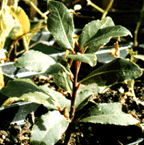 Bay
Sweet Laurus nobilis Lauraceae family
Bay
Sweet Laurus nobilis Lauraceae family
Usages: Cosmetic, culinary, decorative, and medicinal.
Height averages up to 10 feet ; width varies.
Plant care: Full sun to light shade; moderately rich, well drained soil.
Bay leaves can be harvested and dried throughout the year. Early in the
day, cut or pick individual older leaves as needed. |
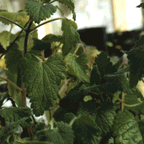 Catnip
Catnip, Nepeta cataria Labiatae family
Catnip
Catnip, Nepeta cataria Labiatae family
Herbal uses: Aromatic, culinary, decorative, and medicinal. Dried leaves
add fragrance to potpourris and are used in cat toys.
Plant care: Full sun to light shade; average, sandy, well-drained soil
.Hardy herbaceous perennial |
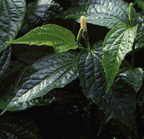 Cha-Plu
Piper sarmentosum
Cha-Plu
Piper sarmentosum
Flavor: aromatic
Usage parts: leaves - cooking, stalk: medicinal
Medicinal use: Whole plant- expectorant; leaves - carminative
Plant care: tropical, partly shade |
 Pakshee (Cilantro)
Coriandrum sativum
Pakshee (Cilantro)
Coriandrum sativum
Usages: Aromatic, culinary, decorative, and medicinal. Ripe seeds have
a pleasant citrus scent and can be used in potpourris
Plant care: Hardy annual; hardiness zones are not applicable to annuals.
Full sun to partial shade; fairly rich, light, well-drained soil with a
pH of 6.6. |
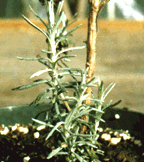 Curry
Helichrysum angustifolium
Curry
Helichrysum angustifolium
Flavor: Indian curry aromatic
Usage parts: fresh leaves, flowers and seeds
Usage in cooking: meats, vegetables
Plant care: semi-perennial, cool and moist |
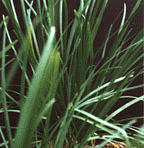 Guichai (garlic chive)
Allium tuberosum
Guichai (garlic chive)
Allium tuberosum
Flavor: garlicky, hot
Usage parts: fresh leaves, stalk, and flowers
Usage in cooking: salad, stir-fry with seafood, garlic substitute
Medicinal use: Plant care: perennial
Plant care: perennial, cool temperature |
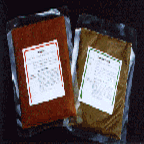 Gang dang/Gang kheo whan
(Red/Green curry paste)
Gang dang/Gang kheo whan
(Red/Green curry paste)
Flavor: spicy
Usage parts: whole
Usage in cooking: all soup and dry curry dishes with meat and vegetable |
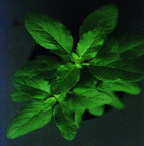 Ga-prao (holy basil)
Ocimum sanctum Linn, LABIATAE
Ga-prao (holy basil)
Ocimum sanctum Linn, LABIATAE
Flavor: aromatic
Usage parts: leaves, seeds
Usage in cooking: leaves - spicy dishes, seeds- medicine
Medicinal use: carminative, anti diarrheal, anti-emetic
Plant care: tropical tender 58 degrees and up |
 Horapah (Thai sweet basil)
Ocimum basilicum Linn. LABIATAE
Horapah (Thai sweet basil)
Ocimum basilicum Linn. LABIATAE
Flavor: mild - sweet
Usage parts: leaves and seeds
Usage in cooking: leaves- in all curries and other spicy dishes seeds-
desserts
Medicinal use: Alleviates stomach spasms and cramps, chronic gastritis,
indigestion and constipation
Plant care: tropical, tender |
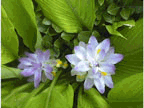 Khamin Khao (Hidden Ginger)
Curcuma Petiolata. ZINGIBERACEAE
Khamin Khao (Hidden Ginger)
Curcuma Petiolata. ZINGIBERACEAE
Flavor: mild aromatic; ginger like
Usage parts: Rhizome, flowers
Usage in cooking: fresh in dips or mix in sauce
Medicinal use: Rhizome- anti diarrheal, anti-emetic, antipyretic; external
use as astringent for wound
Plant care: perennial, deciduous, partly shade |
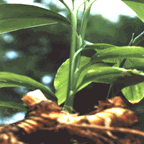 Kha (galanga)
Languas galanga
Kha (galanga)
Languas galanga
Flavor: aromatic, mild-spicy
Usage parts: rhizome, flowers, young leaves
Usage in cooking: most of curry pastes, hot & sour soup, seafood
dishes, chicken with galanga soup
Medicinal use: carminative, indigestion
Plant care: tropical somewhat hardy |
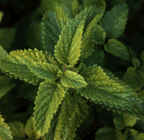 Lemon Balm
Melissa officinalis
Lemon Balm
Melissa officinalis
Flavor: soapy lemon fragrance
Usage parts: fresh leaves in meat sauce, salad or tea
Herbal uses: Aromatic, cosmetic, culinary, and medicinal. The dried
leaves scent potpourris. Lemon balm is used in a facial steam to clean
the skin. It also is used in teas, beers, and wine and with fish, mushrooms,
and soft cheeses. Fresh leaves are used in salads, marinades for vegetables,
chicken salad, and poultry stuffings. It can be grown in containers.
Plant care: perennial, full sun, seed spread aggressively
|
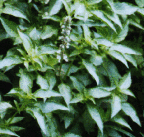 Mangluk (lemon basil or hairy basil)
Ocimum basilicum Linn.f.var.citratum Back. LABIATAE
Mangluk (lemon basil or hairy basil)
Ocimum basilicum Linn.f.var.citratum Back. LABIATAE
Flavor: aromatic, minty
Usage parts: leaves, seeds
Usage in cooking: leaves - salad, garnishing, some curry dishes; seeds
dessert
Medicinal use: laxative, carminative
Plant care: tropical (tender) |
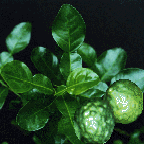 Magrood (Kaffir lime or leech lime)
Citrus hystrix DC. RUTACEAE
Magrood (Kaffir lime or leech lime)
Citrus hystrix DC. RUTACEAE
Flavor: Sour fruit, lemony aromatic leaf
Usage parts: leave, fruit peel, fruit juice
Usage in cooking: fruit peel- curry paste; leave-hot & sour soup,
curry dishes
Medicinal use: fruit juice- anti scurvy, expectorant; anti dandruff
fruit peel- relief of stomach pain, carminative
Plant care: Tropical (perennial in mild weather) |
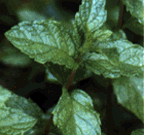 Spear mint
Spearmint Mentha spicata
Spear mint
Spearmint Mentha spicata
Herbal uses: Aromatic, cosmetic, culinary, and medicinal. Fresh or dried
leaves scent sachets and potpourris. Spearmint is used in baths to refresh
and cool skin, in facials to cleanse the skin, and in lotions. It has a
milder flavor than peppermint and is used in candy, gum, teas, meats, fish,
vegetable dishes, fruit salad, fruit beverages, mint water, vinegars, jellies,
and sauces. It is said to have some medicinal qualities.
Companion planting: This plant is said to repel black flea beetles,
ants, fleas, and various rodents. The leaves can be placed in drawers to
repel moths.
Plant care: Perennial; hardiness zone 5. Full sun to partial shade;
moist, rich, well-drained soil with a pH of 6.5. |
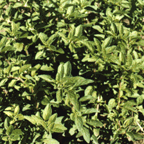 Marjoram
sweet Origanum marjorana
Marjoram
sweet Origanum marjorana
Herbal uses Aromatic, cosmetic, decorative, and medicinal.
Harvesting In late summer to early autumn, harvest plants at the peak
of bloom or just before they are in full flower. Cut the stems with flower
heads attached and dry on screens or hang in a cool, airy place and catch
leaves that fall. Strip leaves and flowers after they are crispy and dry.
Store in airtight containers. Fresh marjoram also can be frozen in ice
cube trays or in foil for up to two weeks.
Plant care: Full sun; well-drained, rich soil |
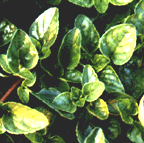 Oregano
Origanum
Oregano
Origanum
Flavor: warm savory fragrance
Usage parts: fresh or dried leaves
Usage in cooking: Italian, Greek food
Medicinal use:
Plant care: se-mihardy perennial, full sun |
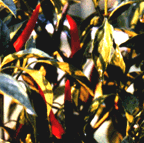 Prik Keenooh (Thai chili pepper)
Capsicum frutescens Linn. SOLANACEAE
Prik Keenooh (Thai chili pepper)
Capsicum frutescens Linn. SOLANACEAE
Flavor: spicy hot Usage parts: seed pods, leaves
Usage parts: pepper pots, fresh leaves
Usage in cooking: all Thai dishes - to add flavor Medicinal use: carminative,
counterirritant, anti pyretic
Plant care: tropical hardy, full sun |
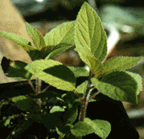 Pineapple Sage
Salvia elegans rutilans
Pineapple Sage
Salvia elegans rutilans
Herbal uses: Decorative, culinary. Attractive flowers. Use in herbal
wreaths & nosegays.
For culinary use. Pineapple flavored leaves. For herbal butter. Use
for drying (leaves are highly aromatic & pungent). Use for fragrance
and pot-pourris. Use in containers. Popular with bees.
Plantcare: Perennial, hardy evergreen shrub; hardiness zone 4-8. Full
sun; fairly rich, light, dry, well drained alkaline soil. |
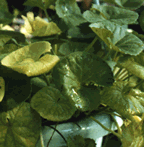 Buabok (Pennywort)
Centella asiatica
Buabok (Pennywort)
Centella asiatica
Usages in cooking: fresh leaf in salad and dip
Medicinal uses: Fresh leaf; treatment of sore throat and thirst, antipyretic,
diuretic, antiarrheal
External use for burn and wound.
Plant care: perennial, partial shade, wet soil |
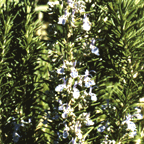 Rosemary
Rosmarinus officinalis
Rosemary
Rosmarinus officinalis
Flavor: pungent, pinelike fragrance.
Herbal uses: Aromatic, cosmetic, culinary, decorative, and medicinal.
The aromatic oil is added to soaps, creams, lotions, perfumes, and toilet
waters. The leaves are used in sachets and potpourris as well as in herbal
baths, facial steams, hair rinses, and dyes. Dried or fresh leaves may
be used to flavor poultry, fish, lamb, beef, tomatoes, mushrooms, cheese,
eggs, potatoes, vinegars, and herbal butters.
Plant care: Tender perennial; hardiness zones 8 to 10. Height to 72
inches; 36 to 72 inches wide. Full sun to partial shade; light, well-drained
soil with a pH of 6.5 to 7.0. |
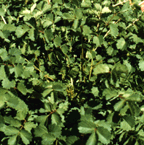 Salad Burnet
Poterium sanguisorba
Salad Burnet
Poterium sanguisorba
Harvesting: Pick young leaves whenever needed.
Herbal uses: Decorative, culinary. Attractive flowers. For culinary
use. Use for flavoring. Use in vinegars. Use in containers.
Plant care: Perennial; hardiness zone 3.
Light and soil: Sun to light shade; average, well drained soil with
a pH of 6.8. |
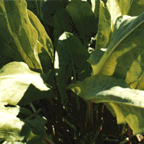 Sorrel (Rumex acetosa )
Sorrel (Rumex acetosa )
Flavor: tangy, sour
For culinary use. Leaves can be used in salads and soups or cooked like
spinach. The leaves of french sorrel are almost tasteless early on in the
growing season, but gain acidity and flavor as the season progresses.
Plant care: perennial, full sun; well drained soil with an acidic pH. |
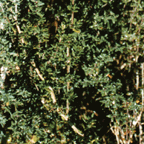 Thyme (Thymus vulgaris)
Thyme (Thymus vulgaris)
Herbal uses: Aromatic, cosmetic, culinary, decorative, and medicinal.
The dried flowers and leaves scent potpourris and sachets. Thyme also is
used as an antiseptic and stimulant in herb lotions and baths. It flavors
vinegars, herbal butter, tea, poultry, fish, stuffings, stews, soups, bread,
mayonnaise, mushrooms, and broccoli.
Plant care: Perennial; hardiness zones 5 to 9. Full sun to partial shade;
light, dry, well-drained soil with a pH of 6.3. |
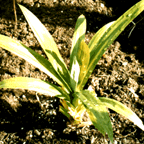 Toey (Pandanus)
Toey (Pandanus)
Flavor: aromatic
Usage parts: leaves
Usage in cooking: flavoring dessert
Plant care: tropical, high moisture |
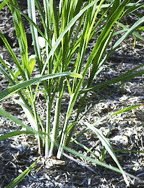 Takrai (lemon grass)
Cymbopogon citratus (DC.) Stapf GRAMINEAE
Takrai (lemon grass)
Cymbopogon citratus (DC.) Stapf GRAMINEAE
Flavor: lemon like
Usage parts: stalk, leaf
Usage in cooking: curry pastes, hot & sour seafood soup, chicken
with galanga soup
Medicinal use: carminative, diuretic
Plant care: tropical (perennial in mild weather)
*Some people use it for mosquitos repellant. |
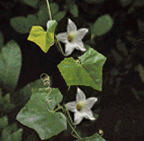 Tum-leung
Coccinia grandis
Tum-leung
Coccinia grandis
Flavor: leaves taste like spinach
Plant care: annual vine, needs partially shade
Usage in cooking: leaves and young stem
Medicinal use: Leaf and root- external use as antipyretic and anti-inflammatory;
fruit - antidiabetic
Plant care: tropical tender |
Purple Ruffle Basil,
Ocimum basilicum, purpurescens
Description: Annual with leafy stems and thin branchy roots. Flowers
are two-lipped, 1/2" long, lavender and grow in racemes at top of stems.
Leaves are opposite, ovate with an entire margin. They are also 2-3 inches
long, dark maroon-purple and shiny. Fruit are tiny, dark brown seeds.
Usages: Aromatic, cosmetic, culinary, medicinal. Cosmetic uses are in
herbal bath mixtures and for bringing luster to the hair.
Plant care: Annual; hardiness zone 4-10. Height and width: Height 12-24
inches; width 12 inches. Full sun; rich, moist, well-drained soil with
a pH of 5.5-7.5. |
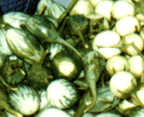 Thai Eggplant
Thai Eggplant
Flavor: Crunchy vegetable with a lot of seeds
Plant care: annual, needs full sun and well drained soil
Culinary uses: use in most of Thai curry dishes and dips |
Purple Basil
Ocimum basilicum
Description: Same characteristic as Purple Ruffle Basil except
the leaves have no ruffle.
Harvesting: Harvest in early Autumn before the cold weather arrives
and the leaves turn limp and yellow. Cut the long, leafy stalks for drying
just before the plant comes into flower. Spread them out in a shady place
or wire mesh to encourage quick drying. Do not hang in bunches as the leaves
dry to slowly and can mold. Oven drying is not advised, as the leaves scorch.
Basil can be frozen--chop fresh into ice cube trays and add a small amount
of water.
Herbal uses: Aromatic, cosmetic, culinary, medicinal. Culinary uses
for flavoring include the fresh leaves which are used in tomato sauces,
to make pesto sauce. It is used in Italian, Mediterranean,Thai , and Japanese
cooking and is good with veal, lamb, fish, poultry, white beans, pasta,
rice, tomatoes, cheese, and eggs. Purple basil is also excellent used in
vinegar and as a garnish. It is aromatic and is used for drying and for
fragrance in pot-pourris and sachets. Cosmetic uses are in herbal bath
mixtures and for bringing luster to the hair. Basil can be grown in containers
and makes an excellent ornamental plant in the landscape.
Plant care: Annual; hardiness zone 4-10. Height 12-24 inches; width
12 inches. Full sun; rich, moist, well-drained soil with a pH of 5.5-7.5.
Companion planting: Improves growth and flavor of asparagus, tomatoes
and most vegetables. Do not plant Basil with cabbage or snap beans. |

